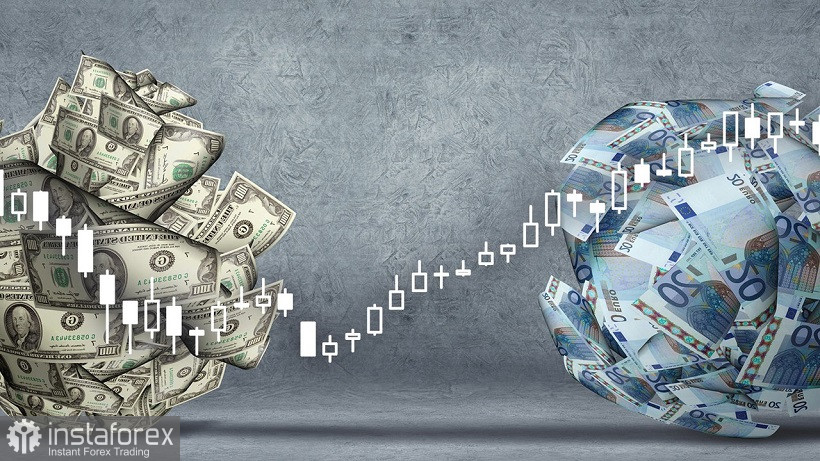Bulls of EUR/USD could not conquer the 11th figure, after which the initiative was expected to be intercepted by bears. Long positions on the pair were initially unreliable: there are no grounds for a trend reversal at the moment, and, consequently, any upward pullbacks have signs of correction.
Nevertheless, it is worth admitting that this time the correction pause was delayed: traders not only approached the 1.1100 mark, but also overcame it, reaching the target of 1.1138 (two-week high). At this price level, the upward momentum stalled, as many traders began to take profits and simultaneously open short positions.

Given the unstable fundamental picture, long positions a priori look unreliable - market participants clearly do not believe in a trend reversal, so they stop as soon as they cross one or another resistance level. This was the case with the 1,1000 mark (bulls besieged this target for several days, attacking and returning back), so it seems to be happening with the 1,1100 mark. The temporary respite was due to optimism about the prospects of the negotiation process between Russia and Ukraine. However, traders cannot hold on to "naked optimism" for a long time, or rather, they cannot hold longs for the EUR/USD pair for a long time. Concrete results were needed for the development of the upward movement, and they are not available today. And although the parties continue negotiations, at the same time they admit that they are going "slowly" and "hard".
In this case, the absence of a result is also a result. The protracted negotiations played into the hands of dollar bulls, who strengthened their positions due to the growth of anti-risk sentiment. Now the "negotiating factor" is already working in favor of the US currency. And here it is necessary to emphasize once again that the European currency in the EUR/ USD pair plays the role of a slave, while the leading role is played by the greenback, which in turn reacts sharply to geopolitical factors. Therefore, a change in the geopolitical situation will be the starting point for a trend reversal. All other fundamental factors are secondary, they are able to provide EUR/USD bulls with only temporary support. All this suggests that it is now advisable to use any more or less large-scale corrective pullbacks to open short positions – at least to the 1.0990 mark (the Tenkan-sen line on the daily chart).
By the way, another reason for a corrective price increase may be a telephone conversation between US President Joe Biden and Chinese President Xi Jinping. The rhetoric of the Chinese leader is likely to increase the risk appetite, allowing bulls of EUR /USD to go on the counterattack. But in this case, in my opinion, you should not succumb to the illusions of price growth. Verbal "interventions" of a political nature, as a rule, have a short-term impact.
It should also be noted that in addition to geopolitical factors, the dollar enjoys support from the Federal Reserve. And although the results of the US central bank's March meeting did not turn out to be "ultra-hawkish" (as many traders expected), the Fed clearly outlined the further course of tightening monetary policy, announcing six more increases of 25 points this year (that is, at each subsequent meeting in 2022).
Moreover, some representatives of the Fed do not rule out a more aggressive rate hike. In particular, today, a member of the Fed's Board of Governors, Christopher Waller, said that the current macroeconomic conditions "allow us to raise the rate by 50 points in May," but "geopolitical risks require caution for now."
This suggests that in case of stabilization of the geopolitical situation, the central bank is likely to consider the issue of a 50-point hike at the May meeting. At least such expectations will prevail in the market, supporting the US currency. In other words, the Fed continues to be an "ally" of the dollar, while the European Central Bank exerts background pressure on the euro, taking a fairly soft position.
Summarizing what has been said, it should be noted that the prevailing fundamental background does not contribute to a trend reversal or even to a large-scale corrective growth. Therefore, it is advisable to use the upward bursts now to open short positions.
Technically, the pair on the D1 timeframe is located between the middle and lower lines of the Bollinger Bands indicator, under the Kumo cloud, but above the Tenkan-sen line. To confirm the ambitions of the upward movement, bulls need to overcome the Kijun-sen line – that is, to gain a foothold above the 1.1150 mark. The main (so far) goal of the downward movement is the 1.0900 mark – this level of support has been on the defensive since March 9, that is, for the second week. The resumption of the downward trend will be signaled by a decrease in the price below the 1.0990 mark (the Tenkan-sen line on the same timeframe). In this case, the Ichimoku indicator will form a bearish Parade of Lines signal.
 English
English 
 Русский
Русский Bahasa Indonesia
Bahasa Indonesia Bahasa Malay
Bahasa Malay ไทย
ไทย Español
Español Deutsch
Deutsch Български
Български Français
Français Tiếng Việt
Tiếng Việt 中文
中文 বাংলা
বাংলা हिन्दी
हिन्दी Čeština
Čeština Українська
Українська Română
Română

